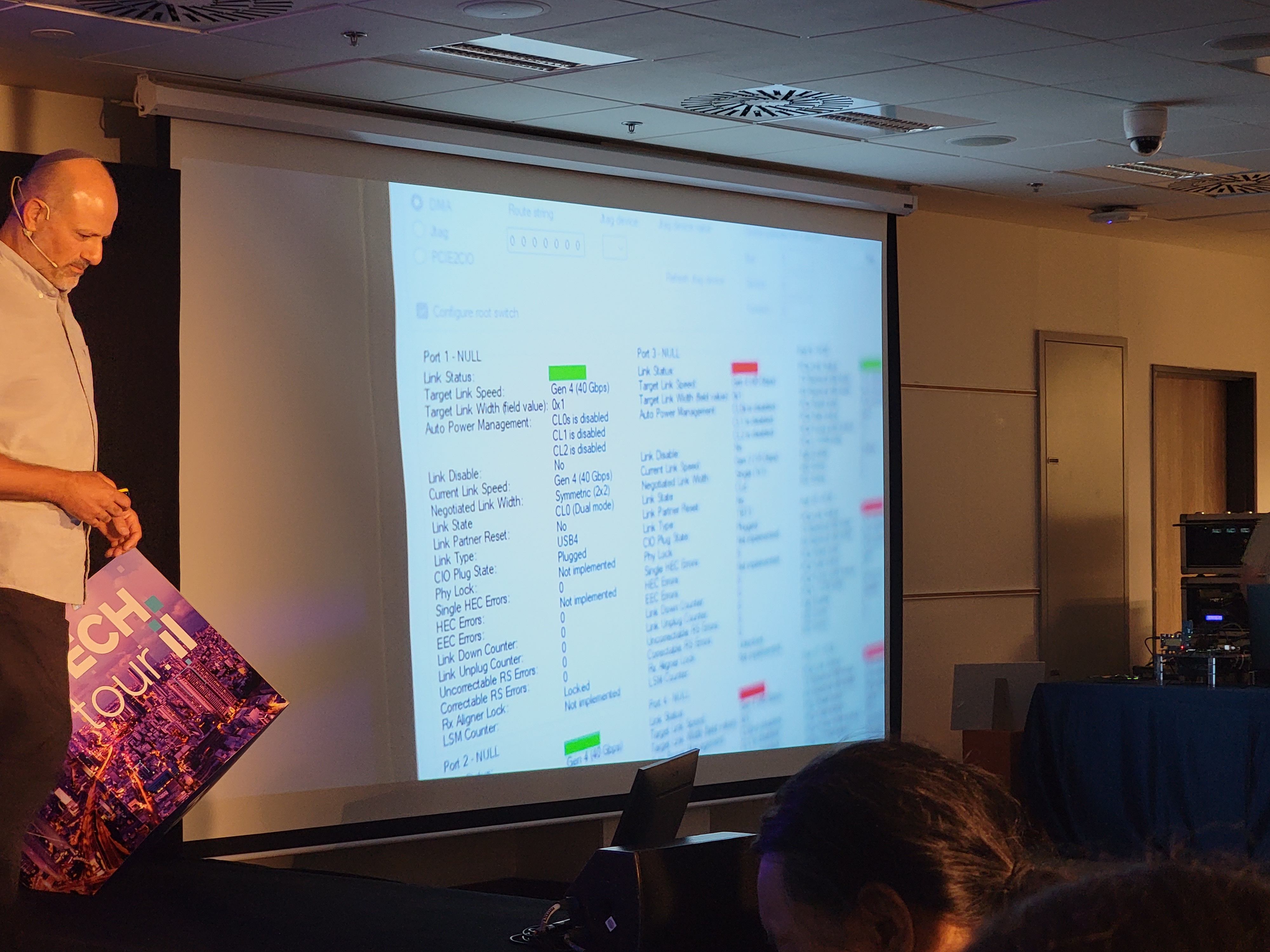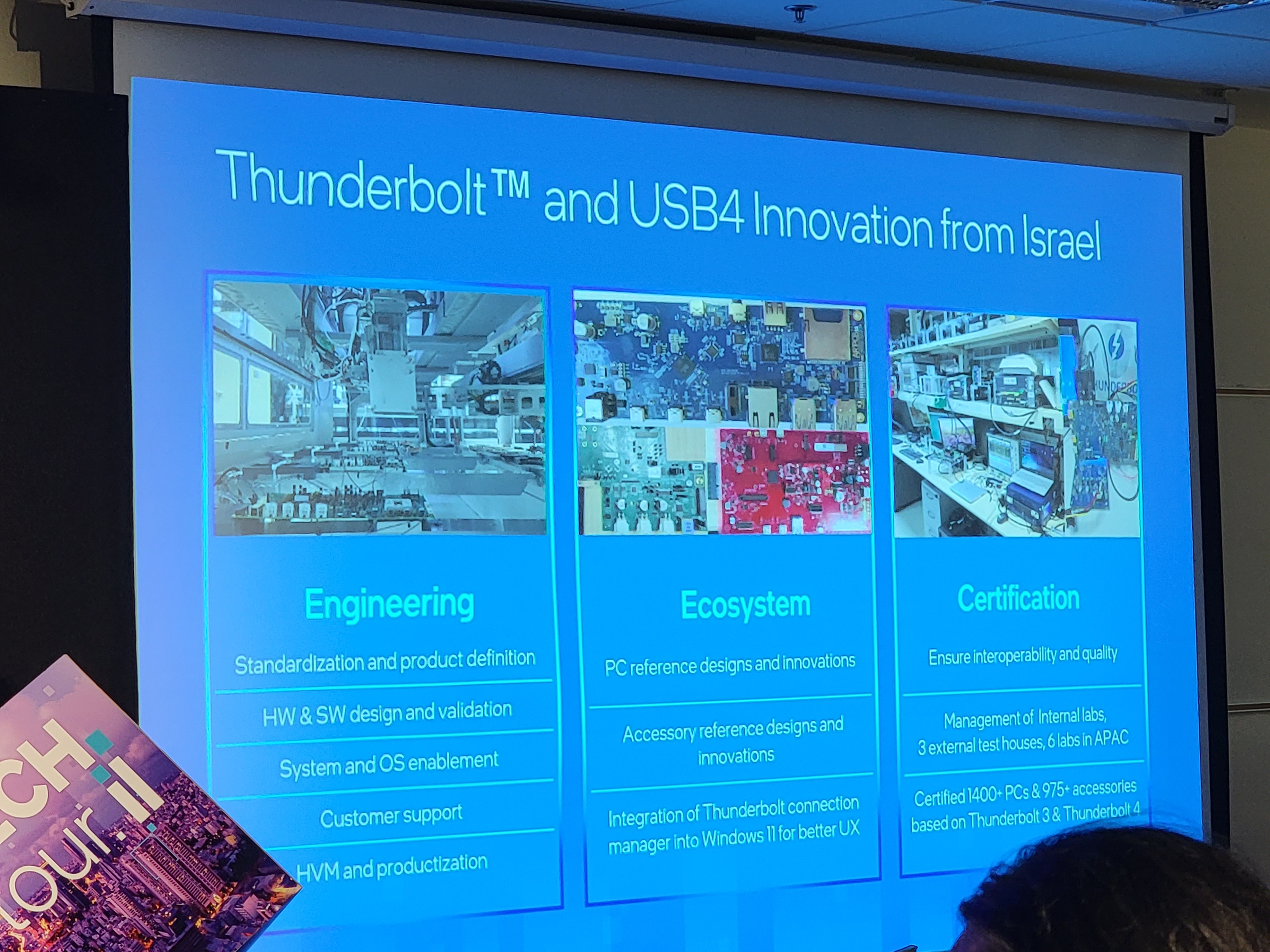Intel Shows First 80 Gbps Thunderbolt Demo, Spec Is Unnamed for Now
Twice the bandwidth.
We're here at the Intel Development Center (IDC) in Haifa, Israel, for the second day of the company's Technology Tour 2022, where the company is sharing new information about its latest products. Today the company showed a live video of the first test system to run with an 80 Gbps Thunderbolt connection, but it stopped short of naming the new interface.,

Intel didn't share many details, but the demo consisted of dual Thunderbolt lanes, with each running at 40 Gbps (for a total of 80 Gbps). That's twice the performance of Thunderbolt 4, which tops out at 40 Gbps in aggregate.
The 80 Gbps connection ran across a USB-C cable. Intel didn't announce a name for the faster interface or mention when it will come to market. For now, all we know is that it will double the speed of the existing Thunderbolt 4 connection.
Thunderbolt 4 currently leverages the USB 4 version 1.0 specification, and the new version of Thunderbolt employs the increased throughput of the USB 4 version 2.0 spec announced earlier this month.
Intel tells us that it hasn't committed to a naming scheme for the 80 Gbps Thunderbolt interface yet. Given the USB 4 'version 2.0' branding scheme, it's possible that Intel could brand this as Thunderbolt 4 version 2 or use some other type of designation for an incremental update. Intel could also name it Thunderbolt 5, but that feels unlikely.

Intel's IDC in Haifa is responsible for all things Thunderbolt and USB at Intel, as shown in the above slide. That remit includes product definition, hardware, software design and validation, high volume manufacturing (HVM), and productization. The group also supports the ecosystem and runs nine facilities worldwide that test and certify Thunderbolt products.
For more info on USB 4 and Thunderbolt 4, head to our USB 4: Everything We Know article.
Get Tom's Hardware's best news and in-depth reviews, straight to your inbox.

Paul Alcorn is the Editor-in-Chief for Tom's Hardware US. He also writes news and reviews on CPUs, storage, and enterprise hardware.
-
InvalidError When you have to do multi-cable lane bonding of ludicrously expensive interfaces and cables to reach a target data rate over copper wiring, that looks like a sign that high-speed interfaces are long overdue for an optical upgrade.Reply -
-Fran- Reply
Or you just need a new cable with more lanes in it xDInvalidError said:When you have to do multi-cable lane bonding of ludicrously expensive interfaces and cables to reach a target data rate over copper wiring, that looks like a sign that high-speed interfaces are long overdue for an optical upgrade.
Regards. -
InvalidError BTW, in the spirit and tradition of horrible names by various standards organizations lately, I propose that doubling TB4's bandwidth by simply doubling the lane count be called TB4.1-gen1x2, which leaves the door open for nudging the bandwidth up some more by increasing the per-lane bandwidth from 20Gbps to 32-40Gbps further down the lane and call that TB4.2-gen2x2.Reply -
peachpuff Reply
I prefer the simple usb 4.1 4.2 4.3 and so forth naming scheme.InvalidError said:BTW, in the spirit and tradition of horrible names by various standards organizations lately, I propose that doubling TB4's bandwidth by simply doubling the lane count be called TB4.1-gen1x2, which leaves the door open for nudging the bandwidth up some more by increasing the per-lane bandwidth from 20Gbps to 32-40Gbps further down the lane and call that TB4.2-gen2x2. -
Kamen Rider Blade Reply
NOOOOOOOOOOOOOOOO!!!!!!!!!!!!!!InvalidError said:BTW, in the spirit and tradition of horrible names by various standards organizations lately, I propose that doubling TB4's bandwidth by simply doubling the lane count be called TB4.1-gen1x2, which leaves the door open for nudging the bandwidth up some more by increasing the per-lane bandwidth from 20Gbps to 32-40Gbps further down the lane and call that TB4.2-gen2x2.
Don't give into the bad naming scheme that breaks historical naming precedence madness.
It should be called "Thunderbolt 5" -
InvalidError Reply
I failed: I forgot to throw in the extra arbitrary letter to differentiate a numerical re-branding of an existing standard (ex.: HDMI 2.0 vs 2.1) from an updated implementation of the standard (2.1a) that supports additional features :DKamen Rider Blade said:NOOOOOOOOOOOOOOOO!!!!!!!!!!!!!!
Don't give into the bad naming scheme that breaks historical naming precedence madness. -
edzieba Reply
Good news then: they're not using cable-bonding.InvalidError said:When you have to do multi-cable lane bonding of ludicrously expensive interfaces and cables to reach a target data rate over copper wiring, that looks like a sign that high-speed interfaces are long overdue for an optical upgrade. -
Kamen Rider Blade Reply
=::::::::::::::::::(InvalidError said:I failed: I forgot to throw in the extra arbitrary letter to differentiate a numerical re-branding of an existing standard (ex.: HDMI 2.0 vs 2.1) from an updated implementation of the standard (2.1a) that supports additional features :D
Don't add in HDMI's non-sense on top! -
MattD-Kauai Does this underwhelm anyone else? I mean what is the actual point of Thunderbolt anymore. The USB 4 2.0 is already going to be the same speed and be available to anyone without having to kiss the Intel posterior for rights.Reply
I would think most motherboard MFGs would just implement the USB config across all brands of CPUs. So is Intel just wasting R&D money to stay relevant in this interface? -
InvalidError Reply
Thunderbolt has been license-free for a few years already and some AMD X570 motherboards have TB3.MattD-Kauai said:The USB 4 2.0 is already going to be the same speed and be available to anyone without having to kiss the Intel posterior for rights.
While USB may be good enough for most everyday use, Thunderbolt is basically external PCIe with much lower overhead than USB, which is kind of important for high-performance stuff like external GPUs.MattD-Kauai said:The USB 4 2.0 is already going to be the same speed and be available to anyone without having to kiss the Intel posterior for rights.
IMO, Thunderbolt is what we should have had with type-C instead of USB3.